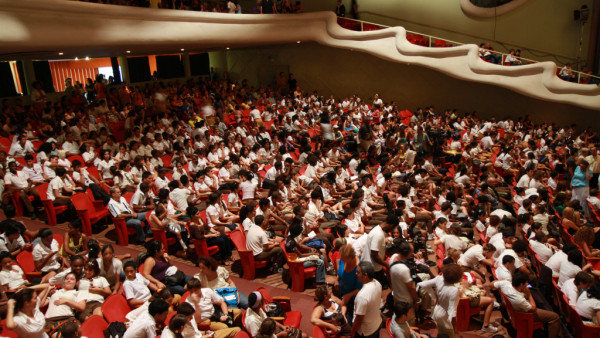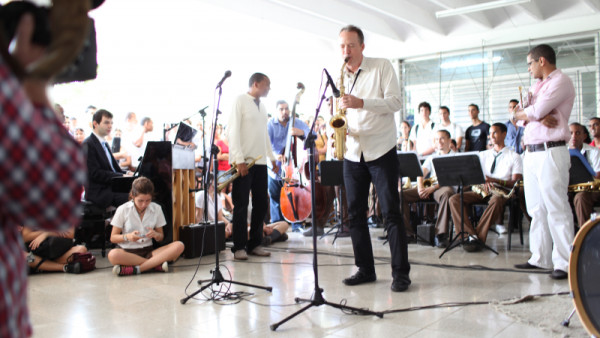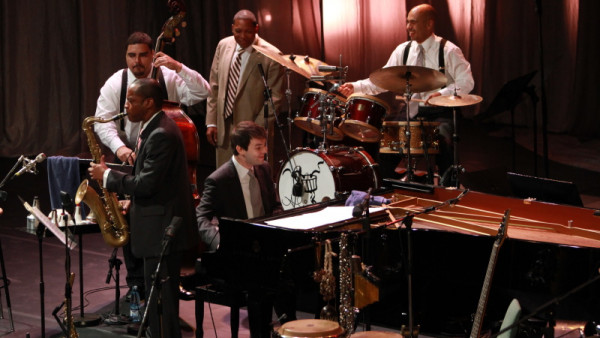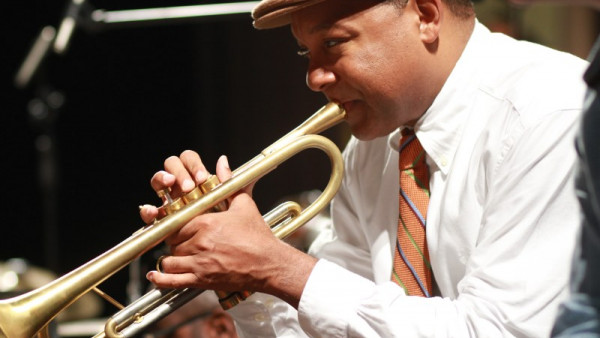In Havana, Jam Sessions With a Master Trumpeter
HAVANA — Wynton Marsalis pulled a young Cuban trumpeter aside as he left the Mella Theater here on Wednesday after a Jazz at Lincoln Center Orchestra concert. The band was here for a residency that ended over the weekend, and Mr. Marsalis had seen 17-year-old Kalí Rodríguez play a few nights earlier at an official reception for the American musicians.
“He told me, ‘You have something special,’ ” recalled Mr. Rodríguez, who has been studying music for seven years at the Amadeo Roldán Conservatory in Havana.
Mr. Marsalis led Mr. Rodríguez to the empty theater and gave him a late-night lesson, playing blues on the piano while Mr. Rodríguez played his trumpet. The master trumpeter gave his pupil tips on musical phrasing and some encouragement as well, Mr. Rodríguez said.
“He told me, ‘You’re serious about what you do, and I like what you do,’ ” added Mr. Rodríguez, who said he was so overwhelmed by Mr. Marsalis’s attention that he broke down in tears midway through the class. “I felt like my soul was bursting out of my body. I mean, if Wynton Marsalis says you’re good at the trumpet, then that’s a big deal.”
Not everyone, though, was awed by the famous American players who descended on Havana for a whirlwind series of encounters that took them from dark rumba joints to the scruffy, vibrant conservatories where Cuba’s young talent is schooled. Dayrón Rodríguez, no relation to the trumpeter, a 12-year-old bongo fiend, didn’t flinch when he was invited to jam onstage with the Lincoln Center band and 13 other Cuban musicians for the rousing Saturday finale of the group’s residency. Mr. Rodríguez, the trumpeter, also played in the concert.
“It’s not the first time I’ve played with great musicians,” said Dayrón, who noted that he had sat in with Yaroldy Abreu Robles, a family friend and percussionist for Chucho Valdés’s Afro-Cuban Messengers.
A grinning Dayrón skipped onto the stage on Saturday night. Along with his bongos he brought a copy of a CD on which he had played, flashing it to band members whenever he got the chance.
The Lincoln Center players came to spread the word of American jazz to Cuban music lovers, and they found an eager audience. Cuban musicians are hungry for all the information they can get. Relatively few foreign bands visit Cuba, and the island’s Internet reach is low. (In a recent government survey less than 3 percent of Cubans said they had been online in the past year.)
Several of the teenage students who jammed with the Lincoln Center players last week said they had never used the Internet and did not have access to a computer or own an MP3 player. They relied on people who traveled overseas to share music with them, they said.
Many members of the Lincoln Center group said they were impressed by the young musicians who performed at workshops, sat in on rehearsals and filled the hotel lobby at night to pepper them with questions. “I love their talent, their attitude, their seriousness and their culture,” said Carlos Henriquez, the Lincoln Center bass player. “Their dedication is unbelievable. We don’t get that in the States.”
There was much talk of bridges last week: the one between Cuba and the United States, and the one between Afro-Cuban music and American jazz.
Jazz at Lincoln Center came trundling over that bridge on Oct. 2 to jam with Cuban stars and teenage students, to give a workshop for children and to perform four concerts with a lineup of Cuban players that included Chucho Valdés; Eliade Terry, known as Don Pancho, the country’s foremost chekeré player; Bobby Carcassés; and Orlando Valle, known as Maraca.
“The bridge was built when Chano Pozo and Dizzy started doing their thing — even before that,” said Mr. Henriquez, referring to the historic collaboration in the late 1940s between that Cuban percussionist and Dizzy Gillespie. “What we’ve done this week is repave the bridge.”
This was possible partly because American officials are interpreting travel restrictions less rigidly under President Obama than they did under George W. Bush. They are letting more Cuban artists visit America, and vice versa.
Now that the bridge is in use again, the musicians wondered how to keep the traffic flowing. Mr. Valdés, the veteran pianist and co-artistic director of the residency, said the next step would be to get American musicians to come to Havana’s jazz festival in December. The festival has flagged in recent years, as it became difficult for the Americans to attend after President Bush tightened travel restrictions in 2003.
“Let anyone come who wants to come,” Mr. Valdés said during a rehearsal break last week. “I would open the door really wide.”
Mr. Valdés also wants to see more Cubans and Americans participating in exchange programs. “Imagine if we could get Americans coming here to study Afro-Cuban rhythms, coming and going without any kind of problem, without politics getting in the way,” he said. “That would be my dream.”
For about 200 years Afro-Cuban rhythms nourished the American music from which jazz emerged, as commerce and people flowed freely between Havana and New Orleans. But that rich trade was essentially shut down when the United States severed diplomatic and commercial ties with Cuba and its Communist leader, Fidel Castro, in the early 1960s.
The two cities may be cut off from each other, but the spirit of New Orleans was present in Havana during the Lincoln Center residency. “I see many things here that are exactly like New Orleans: the architecture, the feeling of the people, the climate, the community,” said Mr. Marsalis, a native of New Orleans.
He pointed to the shared African roots of the roll call, in which New Orleans musicians call the names of deceased players, and the Yoruba blessing sung in Cuban rumba; and to the influence the Cuban habanera rhythm had on ragtime. “Cuban music is in the roots of our music. This is an opportunity to reconnect, to deepen our communality” he said.
So it was fitting that the penultimate event of the residency should include a New Orleans-style parade. On Saturday the players treated 1,500 music students from five schools around Havana to a workshop at the Mella Theater, dissecting the “three pillars” of jazz — swing, blues and improvisation — and bringing students onstage to play with them.
At the end the audience danced and clapped as the Americans played blues and paraded through the auditorium, trailing a line of Cuban trumpeters, violinists, clarinetists and saxophonists.
And then the band marched out of the theater, through the stage door and into the warm Havana afternoon, still tooting their horns, dancers twirling handkerchiefs behind them. A crowd waved and cheered as the musicians headed to their bus.
Then the sound of brass trailed off, and the players were gone.
Source: NY Times





